Chris Andreadis
Offensive Coordinator
Red Mountain High School (AZ)
Introduction
RPOs. No-Huddle. Up-Tempo. Spread offense is all the rage. Try making it through a coaching clinic without hearing those words. Everyone has 4 WRs every snap. No one has an in line TE or a fullback. With all of this happening in mass, I have found that our offensive system has become more rare.
I started my coaching career as an offensive line coach. I learned very quickly that a commitment to the run game has many positive effects:
Overall, I am a big proponent of a balanced attack. I don’t think that necessarily means 50/50 run/pass. To me, balance means the defense is not exactly sure if a run or pass is coming on any specific down, distance or field position out of that specific formation.
While you can certainly spread to run the ball, I believe that using four WRs every snap never forces the defense to play an extra gap (or two) like an In-Line TE and fullback does. In our quest to stay multiple, we found that the 21 personnel “slot” formation gave us everything we wanted. It allowed us to be in our 2-back set (I and off-set), We kept our in-line TE and we had a 2 WR side to throw various passing concepts. Formationally, it put our run strength and pass strength on opposite sides. This forced Defenses to make a decision as to how they would line up. It was the perfect formation for us.
We basically focused on 2 Coverage keys during the game: 1) Where they rolled their safety in a 1-high look, and 2) where they played their Outside LBs. *NOTE: We never saw a defense go “corners over”, but if they did - we would use motion and shifts to get the matchup we wanted.
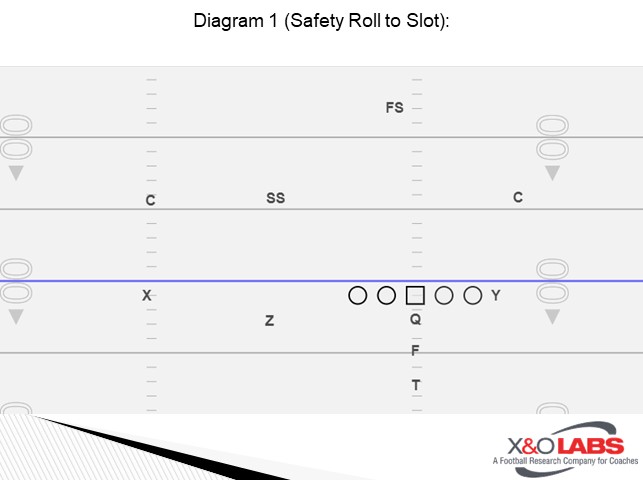
If a team rolled coverage to the slot side (see above), that meant the only “non-box” player left to the TE side was the CB. In our experience, most corners want nothing to do with setting the edge or getting in the box - so that dictated we attack the TE side with off-tackle and perimeter runs ; as well as play-action passes.
Diagram 2 (Roll to TE)
If the defense rolled their safety (see above) to the TE side (for run support), that meant we had our slot WR matched with an OLB. We would attack that side with passes (both drop-back and play-action).
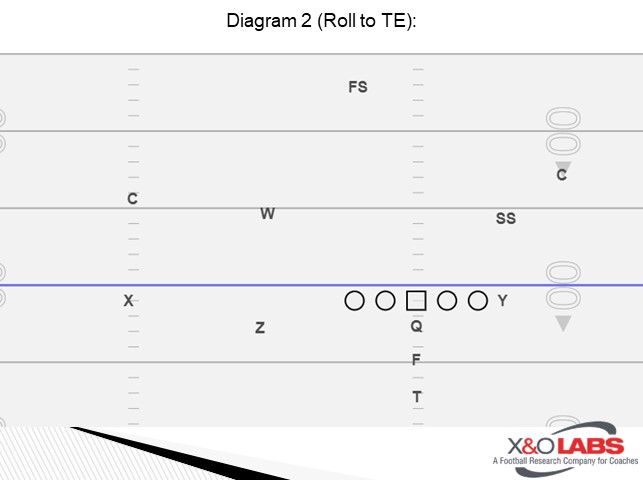
If they stayed in 2-high, and apexed their WOLB, we ran the ball. If they stayed in 2-high and kept a 7-man box, we threw a quick pass to our uncovered slot.
If teams played zero, we had built-in checks. We had a few very talented WRs that were matchup problems for most teams - we picked the matchup we liked, max-protected and took a shot.
Some front considerations:
So, if we were facing an odd-front - did they walk Sam up on the TE?, Did they remove their Kat (weakside OLB) to the slot WR? Did they Eagle down and cover our guard?
Versus an even front - did they bump LBs or just add safety in?
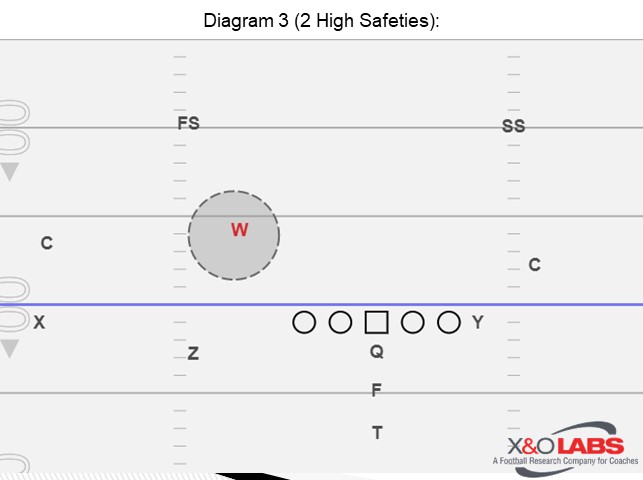
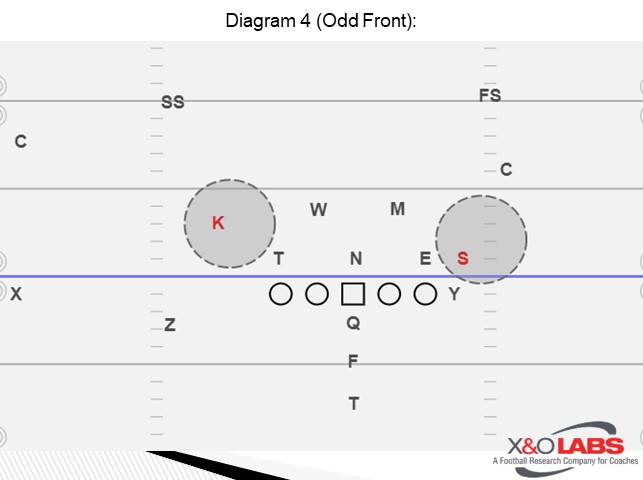
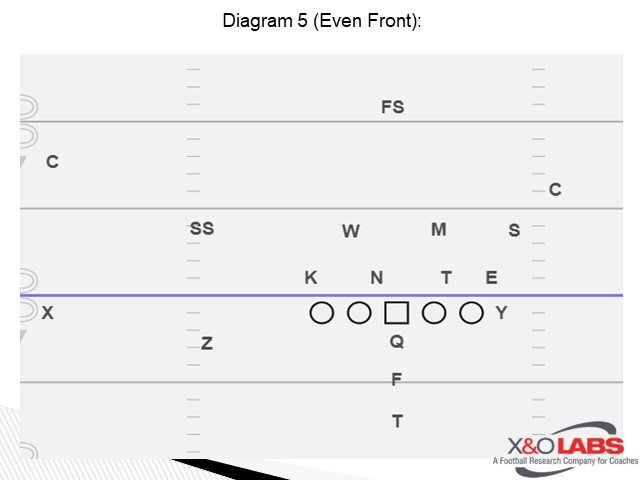
We were also able to run all aspects of our offense, both run and pass. Our best play-action was our “Boot Spine” which was a flood concept with our FB leaking out to the flat. Any two WR pass concept was fair game.
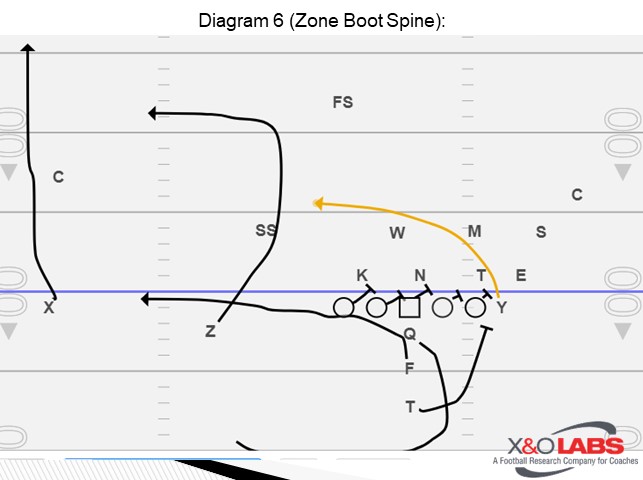
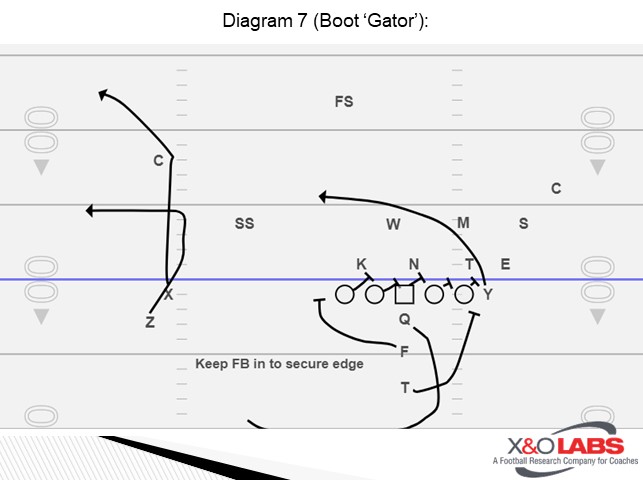
To study game film of this concept, click on the video below:
Offensive Coordinator
Red Mountain High School (AZ)
Introduction
RPOs. No-Huddle. Up-Tempo. Spread offense is all the rage. Try making it through a coaching clinic without hearing those words. Everyone has 4 WRs every snap. No one has an in line TE or a fullback. With all of this happening in mass, I have found that our offensive system has become more rare.
I started my coaching career as an offensive line coach. I learned very quickly that a commitment to the run game has many positive effects:
- It’s a low-risk / high reward offense (only ball carrier fumbles can cost you). The worst thing that can happen is that you run three plays and punt.
- It moves the chains and controls the ball and game tempo.
- It wears down the opposing defensive front - and keeps your defense fresh (and a little ornery if you keep them standing around too long).
Overall, I am a big proponent of a balanced attack. I don’t think that necessarily means 50/50 run/pass. To me, balance means the defense is not exactly sure if a run or pass is coming on any specific down, distance or field position out of that specific formation.
While you can certainly spread to run the ball, I believe that using four WRs every snap never forces the defense to play an extra gap (or two) like an In-Line TE and fullback does. In our quest to stay multiple, we found that the 21 personnel “slot” formation gave us everything we wanted. It allowed us to be in our 2-back set (I and off-set), We kept our in-line TE and we had a 2 WR side to throw various passing concepts. Formationally, it put our run strength and pass strength on opposite sides. This forced Defenses to make a decision as to how they would line up. It was the perfect formation for us.
We basically focused on 2 Coverage keys during the game: 1) Where they rolled their safety in a 1-high look, and 2) where they played their Outside LBs. *NOTE: We never saw a defense go “corners over”, but if they did - we would use motion and shifts to get the matchup we wanted.

If a team rolled coverage to the slot side (see above), that meant the only “non-box” player left to the TE side was the CB. In our experience, most corners want nothing to do with setting the edge or getting in the box - so that dictated we attack the TE side with off-tackle and perimeter runs ; as well as play-action passes.
Diagram 2 (Roll to TE)
If the defense rolled their safety (see above) to the TE side (for run support), that meant we had our slot WR matched with an OLB. We would attack that side with passes (both drop-back and play-action).

If they stayed in 2-high, and apexed their WOLB, we ran the ball. If they stayed in 2-high and kept a 7-man box, we threw a quick pass to our uncovered slot.
If teams played zero, we had built-in checks. We had a few very talented WRs that were matchup problems for most teams - we picked the matchup we liked, max-protected and took a shot.
Some front considerations:
So, if we were facing an odd-front - did they walk Sam up on the TE?, Did they remove their Kat (weakside OLB) to the slot WR? Did they Eagle down and cover our guard?
Versus an even front - did they bump LBs or just add safety in?



We were also able to run all aspects of our offense, both run and pass. Our best play-action was our “Boot Spine” which was a flood concept with our FB leaking out to the flat. Any two WR pass concept was fair game.


To study game film of this concept, click on the video below:









